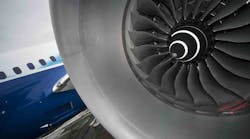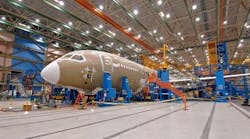Conventional machine tools will have stiff competition at EMO 2001 as several new parallel kinematic machines make their debuts.
A new type of tripod PKM, Heckert's SKM 400 has a special couling mechanism that always pkeeps the main spindle in a horizontal position. Three struts move the machine spindle in the X, Y, and Z directions.
The Ecospeed, from DS Technologie, features a hybrid kinematic design that lets it tackle the machining of aerospace parts.
The Tricept 845 5-axis machining center from Neos Robotics will make its debut at EMO 2001. It features the Modular Element System (MES), which comprises two pillars on a machine bridge that can be angled at 0°, 45°, or 90°. The setup of the MES and the angle of the Tricept machine can be altered numerous times, giving the user a great deal of flexibility.
Hexapods are still finding production niches. Ingersoll's HOH 600 has done well in machining titanium alloys.
Parallel kinematic machines (PKMs) are quietly, but quickly, making inroads into aerospace, automotive, and other applications — an amazing feat, considering the technology is years old. But collaboration European and U.S. machine tool the German control supplier the development of these machines, many of which will be introduced at the upcoming EMO 2001 exhibition in Hannover, Germany.
PKMs can be divided into categories, based on their structural designs. One of the most commercially successful PKM types is the tripod, which moves in the X, Y, and Z directions. With their lightweight design, tripods achieve high dynamics with feedrates up to 4,700 in./min and accelerations as high as 3.5 G. Companies like Index-Werke GmbH, Heckert Werkzeugmaschinen GmbH, and Renault Automation Comau have introduced such machines for turning, milling, and/or drilling applications.
In the turning department, the first lathe using PKM technology comes from Index. Called the V100, it delivers 1-G acceleration and rapid movement up to 2,362 in./min. This machine has a 10,000-rpm spindle, a working area of 9.8 9.85.9 in., and a chuck size of 5.1 in. The SKM 400 from Heckert showcases a new type of tripod for PKMs. Using a coupling mechanism, the main spindle is always kept in a horizontal position. So, by actuating the three struts, the spindle can be moved in X, Y, and Z.
Designed for machining housing-style workpieces in light alloy or steel, the SKM 400 rapid traverses at up to 3,937 in./min and accelerates at 1 G. It also provides 25.6 in. of longitudinal, vertical, and cross movement.
Renault's Urane SX, first detailed in AMERICAN MACHINIST in July 1999 ("Concept and reality on display in Paris," p. 14), is the first PKM with linear motors. The machine has a mobile platform and three parallel, linear-motor-driven systems, each with "arms" that provide axis movement. This configuration lets the machine traverse at 3,937 in./min and accelerate at 3.5 G. The focus of the machine, which was introduced as a prototype at the last EMO show, is the machining of powertrain parts.
Looking at conventional 5-axis milling machines, the rotary axes are the limiting factor when it comes to high dynamics. This is particularly apparent in the aerospace industry, which uses huge machines.
DS Technologie GmbH recently developed a machining center, the Ecospeed, that incorporates a new type of head, called the Sprint Z3. In effect, the machine transfers the motion of three linear axes into the Z axis and two rotary axes. This lets it execute rapid orientation changes and operate the Z-axis stroke.
The Z3 head provides angular velocities of 1,968 in./min, linear accelerations of 32 ft/sec 2 (1 G), and rotary acceleration of 686°/sec 2 . It also offers a tilting angle of ±45° around the A/B axis within a 14.6-in. Z stroke, with a maximum Z-axis travel of 26.3 in.
Another new machine at EMO will be the Tricept TMC 845 from Neos Robotics AB, which sports a modular, reconfigurable design. Its core is the Tricept 805 open-architecture mechanical module.
The modular design is new. Called the Modular Element System, it has two side stands, a bridge, and the Tricept 805 open-architecture mechanical module. The module can be mounted in three orientations: vertical, 45°, and horizontal. This lets the machine be adapted to various machining tasks. Further options include different table and pallet systems, which are placed in front of the basic unit. Since table and pallet changes can be made at any time, the machine is fully reconfigurable.
And finally, hexapods are still in the race. Ingersoll's Horizontal Octahedral Hexapod (HOH 600) has passed stringent tests by the University of Aachen/Germany. Reportedly, the HOH performed well machining titanium alloys, used mainly in aerospace.
Automation solutions for PKMs
Each one of these PKMs has its own kinematic structure. And to move these structures within Cartesian axes, it is necessary to incorporate a real-time transformation on a CNC. Also, a software package has to be implemented on an NC kernel and features like collision detection between struts, error compensation, and calibration have to be considered. Last, but not least, the operator interface needs to be adapted.
Keeping these requirements in mind, PKM builders must use an open-architecture, such as the Siemens Sinumerik 840D. They also need to combine the CNC with digital drives like the Simodrive 611D. In addition, Siemens offers these builders different motor technologies, depending on the strut design. For extendible struts, there are standard servo and hollow-shaft motors. Systems with nonextendible struts can be driven by a servomotor-ballscrew system as well as with linear motors.
With the correct CNC and drives, PKMs can be programmed the same as conventional, Cartesian machine tools, even though they don't have a Cartesian machine coordinate system. This is important because with a PKM system there is a non-linear relation between the machine and workpiece axes. A conventional XYZ machine, on the other hand, has a direct relationship between axes and machine movements. Activating the Z axis, for instance, moves the machine in the Z direction, and moving the Y axis propels the machine in this direction.
Programming a PKM would be difficult if there was no software support. That's why Siemens has developed what is called Real Time Transformations. The benefit of this software feature is that a PKM can be programmed as if it was a conventional Cartesian machine.
The NC program, for instance, can define just X, Y, and Z movements. Then the Transformation calculates the required PKM axis movements, and the PKM behaves like a conventional XYZ machine. Or the NC program defines the movements of a conventional 5-axis Cartesian machine in the form of X, Y, and Z movements of the tool centerpoint plus orientation angles defined by rotary-axis angle values or a couple of other standard expressions. In all cases, the Transformation takes this conventional programming format and calculates in real time the resulting PKM-axes movements.
Several other software features, based on compile cycles, have also been realized on the Sinumerik 840D: extensive static/dynamic error compensation like Space Error Compensation, PKM calibration, collision detection, and PKM-specific characterization methods.
Besides the conventional CNC error compensation, Siemens has also found a way of compensating for different errors of static and dynamic nature during machining. By using a secondary measurement system on a passively moved unit, such as a center tube, the control gathers position information from a point closer to the tool centerpoint. Since this information is in the central tube coordinate system, it has to be transformed into the Cartesian space position of the lower platform. Position control then takes place within the Cartesian coordinate system. This method was realized on the Tricept from Neos Robotics, which showed desirable behavior when it came to thermal drift and process-force compensation.
Mr. Maier is project manager for parallel kinematic machines with Siemens AG, Erlangen, Germany.










